Themed collection New frontiers in covalent organic frameworks: design and applications

Covalent organic frameworks as multifunctional materials for chemical detection
This review highlights how the unique properties of COFs are harnessed to develop different types of chemical detection systems based on the principles of chromism, luminescence, electrical transduction, chromatography, spectrometry, and others.
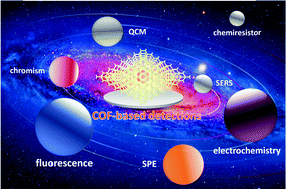
Chem. Soc. Rev., 2021,50, 13498-13558
https://doi.org/10.1039/D1CS00600B
Covalent organic frameworks (COFs) for electrochemical applications
This review article summarizes the design principles and strategies for the synthesis of functional COFs, with a special focus on their potential for electrochemical applications.
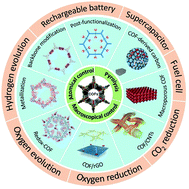
Chem. Soc. Rev., 2021,50, 6871-6913
https://doi.org/10.1039/D0CS01569E
Optoelectronic processes in covalent organic frameworks
Covalent organic frameworks (COFs) are crystalline porous materials constructed from molecular building blocks using diverse linkage chemistries. The image illustrates electron transfer in a COF-based donor–acceptor system. Image by Nanosystems Initiative Munich.
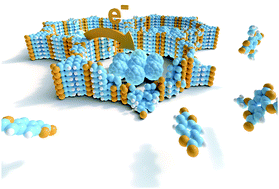
Chem. Soc. Rev., 2021,50, 1813-1845
https://doi.org/10.1039/D0CS00793E
Covalent organic frameworks: an ideal platform for designing ordered materials and advanced applications
Covalent organic frameworks offer a molecular platform for integrating organic units into periodically ordered yet extended 2D and 3D polymers to create topologically well-defined polygonal lattices and built-in discrete micropores and/or mesopores.
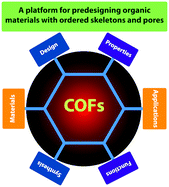
Chem. Soc. Rev., 2021,50, 120-242
https://doi.org/10.1039/D0CS00620C
Solving the COF trilemma: towards crystalline, stable and functional covalent organic frameworks
Strategies in covalent organic frameworks and adjacent fields are highlighted for designing stable, ordered and functional materials.
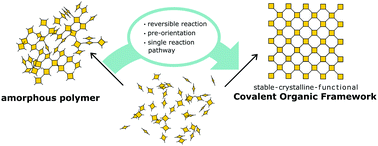
Chem. Soc. Rev., 2020,49, 8469-8500
https://doi.org/10.1039/D0CS01027H
Chiral covalent organic frameworks: design, synthesis and property
Owing to the unique structural features and facile tunability of the subcomponents and channels, chiral COFs show great potential in heterogeneous catalysis, enantioselective separation, and recognition.
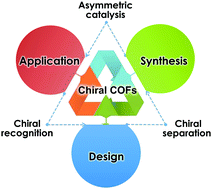
Chem. Soc. Rev., 2020,49, 6248-6272
https://doi.org/10.1039/D0CS00009D
Function-oriented synthesis of two-dimensional (2D) covalent organic frameworks – from 3D solids to 2D sheets
This review provides guidelines for the function-oriented synthesis of 2D COFs from 3D solids to 2D sheets.
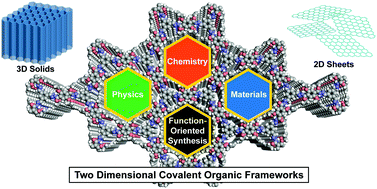
Chem. Soc. Rev., 2020,49, 4835-4866
https://doi.org/10.1039/D0CS00236D
Two-dimensional covalent organic frameworks with hierarchical porosity
This review highlights the state-of-the-art progress achieved in two-dimensional covalent organic frameworks (COFs) with hierarchical porosity, an emerging class of COFs constructed by integrating different types of pores into one framework.

Chem. Soc. Rev., 2020,49, 3920-3951
https://doi.org/10.1039/D0CS00049C
Bulk COFs and COF nanosheets for electrochemical energy storage and conversion
The current advances, structure-property relationship and future perspectives in covalent organic frameworks (COFs) and their nanosheets for electrochemical energy storage (EES) and conversion (EEC) are summarized.
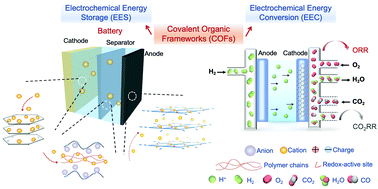
Chem. Soc. Rev., 2020,49, 3565-3604
https://doi.org/10.1039/D0CS00017E
Design and applications of three dimensional covalent organic frameworks
We summarize in this review the current state-of-the-art development of three dimensional covalent organic frameworks.
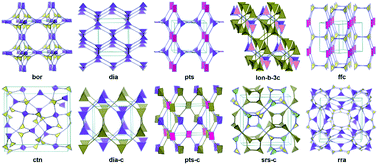
Chem. Soc. Rev., 2020,49, 1357-1384
https://doi.org/10.1039/C9CS00911F
Covalent organic frameworks for separation applications
This review article comprehensively summarizes the recent progress in the development of covalent organic framework materials for separation applications.
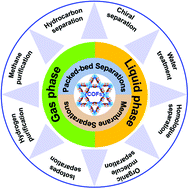
Chem. Soc. Rev., 2020,49, 708-735
https://doi.org/10.1039/C9CS00827F
The luminescent and photophysical properties of covalent organic frameworks
This review highlights the luminescent and unique photophysical properties of covalent organic frameworks. Their potential use in applications related to chemical sensing, photocatalysis, and optoelectronics are discussed.

Chem. Soc. Rev., 2020,49, 839-864
https://doi.org/10.1039/C9CS00807A
Confined growth of ordered organic frameworks at an interface
This tutorial review covers the recent design, synthesis, characterization, and property study of COF thin films and covalent monolayers through interfacial polymerization.
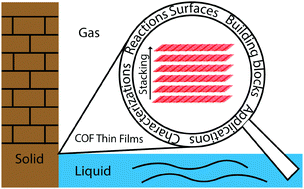
Chem. Soc. Rev., 2020,49, 4637-4666
https://doi.org/10.1039/C9CS00879A
New synthetic strategies toward covalent organic frameworks
This tutorial review highlights the representative advances in the new synthetic strategies toward covalent organic frameworks.
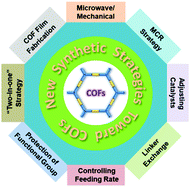
Chem. Soc. Rev., 2020,49, 2852-2868
https://doi.org/10.1039/D0CS00199F
Covalent organic framework nanosheets: preparation, properties and applications
Covalent organic frameworks are crystalline porous materials with 2- or 3-dimensional structures designed modularly from their molecular precursors. Using bottom-up or top-down strategies, single- or few-layer materials can be obtained from them.
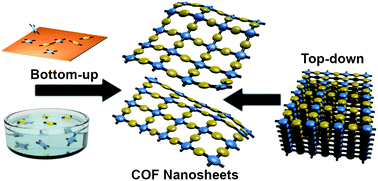
Chem. Soc. Rev., 2020,49, 2291-2302
https://doi.org/10.1039/C9CS00890J
Topological two-dimensional polymers
The structural topology of a 2D network defines its electronic structure.
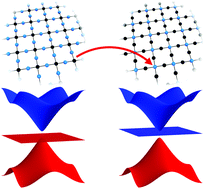
Chem. Soc. Rev., 2020,49, 2007-2019
https://doi.org/10.1039/C9CS00893D
Supramolecular design in 2D covalent organic frameworks
2D covalent organic frameworks (COFs) are a class of porous polymers with crystalline structures. This tutorial review discusses how the concepts of supramolecular chemistry are used to add form and function to COFs through their non-covalent bonds.
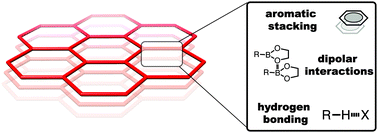
Chem. Soc. Rev., 2020,49, 1344-1356
https://doi.org/10.1039/C9CS00884E
About this collection
Covalent organic frameworks (COFs) represent a new field of rapidly expanding chemical research that takes direct inspiration from covalent dynamic chemistry, translated to the supramolecular level. The success of linking molecules in two and three dimensions to construct extended and highly ordered framework structures moved the chemistry of COFs beyond mere structures to new concepts and methodologies, highlighting the feasibility of prospective applications.
In this themed issue, Guest Edited by Rahul Banerjee (IISER, Kolkata), Bettina Lotsch (Ludwig Maximilian University of Munich) and William Dichtel (Northwestern University), we would like to spotlight the structure -- property relationships in COFs giving rise to fascinating properties, like separation, ionic and electronic transport, catalytic activity, processability and scalability. These attributes are key to adapting COFs to next-generation applications in energy conversion and storage, catalysis, optoelectronics, biomedicine, and beyond. On a more fundamental level, we would like to revisit the growth of COFs, highlight novel design concepts and identify new development areas for COFs which have the potential to ultimately take COFs from mere lab curiosities to technologically relevant materials.